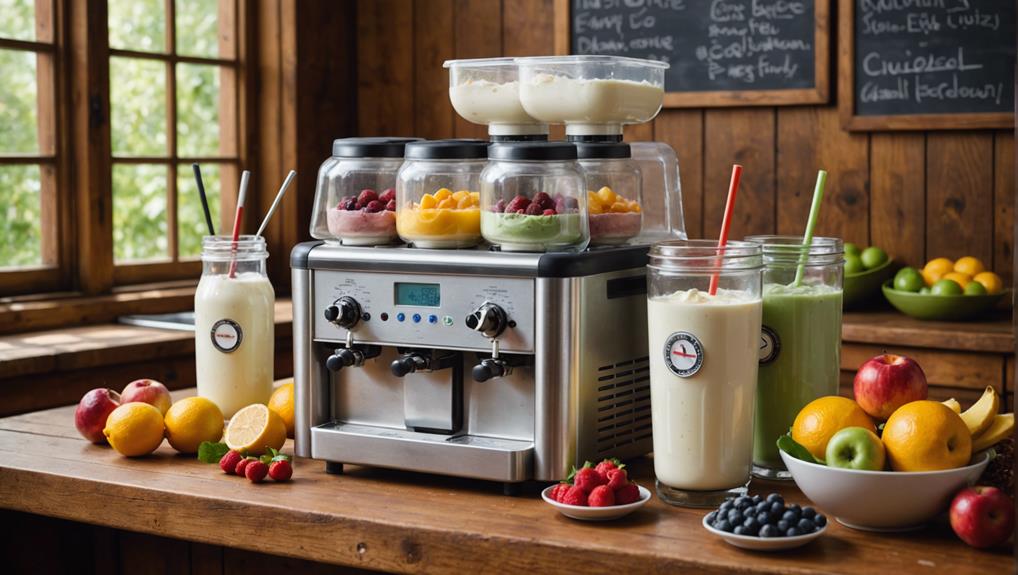Ingredient interactions in frozen yogurt are pivotal for its quality and sensory appeal. Proximate composition, including moisture, protein, fat, and carbohydrates, defines its nutritional content. Ingredients like inulin and isomalt enhance viscosity and texture, leading to a richer mouthfeel and controlled ice crystal formation. Acidity, influenced by components such as fruit purees, and overrun, the measure of incorporated air, are critical for flavor and creaminess. Managing these interactions guarantees an ideal melting rate and stability. Detailed comprehension of these elements is essential for producing high-quality frozen yogurt, enhancing both consumer satisfaction and marketability. Explore further aspects to masterfully craft superior frozen yogurt.
Key Takeaways
- Lactic Acid Bacteria: Lactic acid bacteria influence the fermentation process, enhancing the nutritional properties and flavor profile of frozen yogurt.
- Inulin: Inulin increases viscosity, contributing to a rich texture and slower melting rate, enhancing the sensory experience.
- Isomalt: Isomalt improves creaminess and controls ice crystal formation, optimizing texture in low-fat frozen yogurt formulations.
- Acidity and Overrun: Balancing acidity and overrun is essential for achieving the desired tanginess, creaminess, and texture in frozen yogurt.
- Sweeteners and Additives: Sweeteners and additives significantly impact taste, texture, and overall sensory properties, affecting consumer satisfaction and marketability.
Proximate Composition

Analyzing the proximate composition of frozen yogurt is essential for determining its nutritional content and quality. Proximate composition encompasses the fundamental chemical properties of food, including moisture, protein, fat, ash, and carbohydrates. By examining frozen yogurt samples, researchers can quantify these components, offering a thorough understanding of the product's nutritional profile.
Frozen yogurt, a popular dairy product, is often assessed for its proximate composition to gauge the balance of key nutrients. This analysis reveals the percentage of protein, fat, and carbohydrates, essential for consumer health and dietary planning. The presence of lactic acid bacteria in frozen yogurt not only contributes to its fermentation process but also impacts its nutritional and sensory properties. These bacteria can influence the levels of certain nutrients, such as protein and fat, further affecting the overall proximate composition.
Investigating the proximate composition also allows researchers to evaluate how different ingredients and their interactions modify the chemical properties of frozen yogurt. For instance, variations in milk solids or sweeteners can alter the nutritional profile, thereby influencing both the quality and acceptability of the final product. Therefore, proximate composition analysis is integral for optimizing the formulation and ensuring the nutritional adequacy of frozen yogurt.
Viscosity and Texture
The viscosity and texture of frozen yogurt are crucially influenced by the incorporation of specific ingredients like inulin and isomalt, which enhance its thickness and creaminess. In the field of Dairy Science, these ingredients are pivotal in achieving desired sensory properties, particularly in low-fat formulations. Inulin markedly augments viscosity, contributing to a rich and indulgent texture that enhances consumer satisfaction. Isomalt, on the other hand, leads to a creamy and velvety consistency, effectively counteracting the formation of large ice crystals, which can detract from the smoothness of frozen yogurt.
Key aspects influenced by inulin and isomalt include:
- Viscosity Enhancement: Both inulin and isomalt increase the overall viscosity, resulting in a thicker and more stable product.
- Texture Improvement: The presence of these ingredients ensures a smoother mouthfeel by reducing the perception of ice crystals.
- Sensory Properties Optimization: Enhanced creaminess and thickness contribute to a superior sensory experience, particularly important in low-fat variants.
- Ice Crystal Control: Effective management of ice crystal formation results in a more consistent and enjoyable texture.
Through precise ingredient manipulation, the frozen yogurt industry can produce a product that meets high standards of viscosity and texture, ensuring a consistently delightful consumer experience.
Acidity and Overrun

In addition to viscosity and texture, acidity and overrun play important roles in defining the overall quality and sensory attributes of frozen yogurt. Acidity, primarily influenced by the incorporation of various fruit purees or flavorings, directly affects the tanginess and overall flavor profile. The interaction of ingredients here is vital; maintaining an ideal acidity level ensures that the yogurt possesses the desired sharpness without being overly sour, thereby enhancing the consumer's flavor experience.
Overrun, the measure of air incorporated during the freezing process, has a substantial impact on the creaminess and lightness of the final product. A higher overrun results in a smoother texture and less dense consistency, contributing to a more enjoyable mouthfeel. Conversely, insufficient overrun can lead to a heavier, less palatable product. Achieving the proper balance between acidity and overrun is crucial; too much acidity can overpower the delicate flavors, while too much overrun can dilute the richness.
Therefore, meticulous control over these parameters is essential for producing high-quality frozen yogurt. Ingredient interaction must be carefully managed to harmonize acidity and overrun, ensuring a product that is both flavorful and texturally pleasing, thereby meeting consumer expectations for creaminess and lightness.
Melting Rate Analysis
Understanding how various ingredients influence the melting rate of frozen yogurt is paramount for optimizing its texture and consistency. The melting rate, defined as the time required for the frozen yogurt to shift from a solid to a liquid state, is a critical factor in product development. Key ingredients such as inulin and isomalt have a notable impact on the melting rate by altering the viscosity and texture of the frozen yogurt.
Higher viscosity, achieved through the incorporation of these ingredients, has been shown to slow the melting rate, thereby improving the sensory experience and enhancing product stability. Monitoring and controlling the melting rate is essential for manufacturers aiming to produce a high-quality frozen yogurt that maintains its structure under varying conditions.
To emphasize the importance of ingredient selection on the melting rate, consider the following points:
- Viscosity Enhancement: Ingredients like inulin and isomalt increase viscosity, leading to a slower melting rate.
- Texture Optimization: Higher viscosity contributes to a smoother, creamier texture.
- Sensory Experience Improvement: A slower melting rate enhances the consumer's enjoyment by prolonging the eating experience.
- Stability Maintenance: Improved stability ensures the product retains its desired properties over time.
Sensory Properties

Sensory properties in frozen yogurt, encompassing taste, texture, appearance, and aroma, are paramount for achieving consumer satisfaction and driving product success. Sensory evaluation, typically conducted by a panel of trained testers, is essential for evaluating these attributes and understanding consumer preferences. Factors such as sweeteners, flavors, and additives play a key role in influencing the sensory properties of frozen yogurt.
Taste, influenced by the balance of sweetness and acidity, is a critical determinant of consumer acceptance. Sweeteners, both natural and artificial, play a crucial role in modulating this balance. Texture analysis measures parameters including firmness, creaminess, and smoothness, which are essential for the mouthfeel of the product. Additives such as stabilizers and emulsifiers can enhance these textural properties, ensuring a desirable consistency.
Appearance, including color and visual appeal, impacts the initial consumer perception and acceptance of the product. Aroma, although often overlooked, is integral to the overall sensory experience and can greatly enhance the flavor profile. Understanding and optimizing these sensory properties through rigorous evaluation and ingredient manipulation is important for successful product development and marketability of frozen yogurt. As such, a focused approach on sensory properties ensures the alignment of the product with consumer expectations and market trends.
Frequently Asked Questions
Why Does Frozen Yogurt Upset My Stomach?
Frozen yogurt may upset your stomach due to a combination of probiotic cultures, sugar alcohols, artificial sweeteners, and flavor additives. Additionally, the presence of dairy and insufficient digestive enzymes can exacerbate symptoms in lactose-sensitive individuals.
What Is in Frozen Yogurt Ingredients?
Like a well-orchestrated symphony, frozen yogurt ingredients harmonize to create flavor combinations, nutritional benefits, and cultural variations. Key components include sweetening options, probiotic content, and texture enhancers, ensuring a creamy, delightful experience with every bite.
Can Lactose Intolerant People Eat Frozen Yogurt?
Lactose intolerant individuals may consume frozen yogurt with live cultures aiding lactose digestion. Opting for yogurt alternatives, dairy substitutes, or plant-based yogurt with lower lactose content, alongside digestive enzymes, can enhance tolerance and minimize symptoms.
What Are the Stabilizers in Frozen Yogurt?
Stabilizers such as guar gum, carrageenan, and pectin enhance texture improvement, prolong shelf life, and guarantee ingredient synergy. Achieving ideal ratios through precise production methods is crucial for maintaining frozen yogurt's creamy consistency and smooth texture.
Conclusion
The intricate interplay of ingredients in frozen yogurt mirrors a finely tuned orchestra, where each component contributes to the overall symphony of proximate composition, viscosity, texture, acidity, overrun, melting rate, and sensory properties. The precise balance of these elements dictates the product's quality and consumer acceptance. Thorough analysis reveals that ideal ingredient interactions are essential for achieving desirable sensory attributes and functional properties, underscoring the importance of meticulous formulation in frozen yogurt production.







